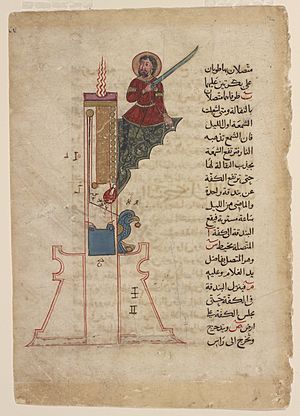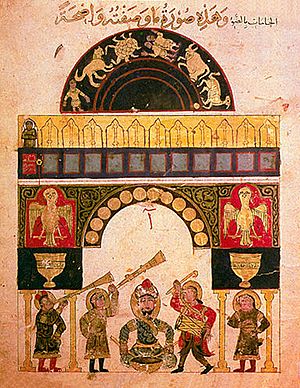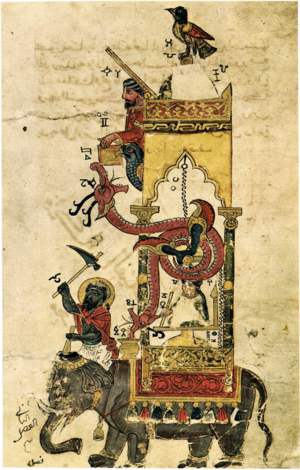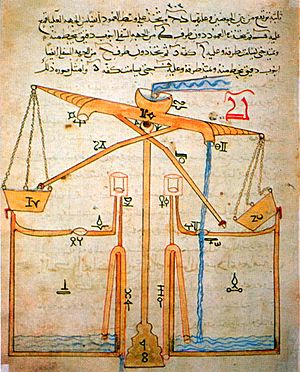Ismail al-Jazari facts for kids
Quick facts for kids Ismail al-Jazari |
|
|---|---|
| Religion | Islam |
| Personal | |
| Born | 1136 CE Jazira, Artuqid State |
| Died | 1206 CE |
| Senior posting | |
| Title | al-Jazari |
Imagine a world without robots or complex machines. Now, imagine a brilliant inventor from long ago who created amazing mechanical devices that were way ahead of his time! That person was Badīʿ az-Zaman Abu l-ʿIzz ibn Ismāʿīl ibn ar-Razāz al-Jazarī, often called al-Jazari. He lived from 1136 to 1206 in a region called Mesopotamia.
Al-Jazari was a true "polymath," meaning he was skilled in many different areas. He was a scholar, inventor, mechanical engineer, artist, and mathematician. He worked for the Artuqid Dynasty, a ruling family in his region. He is most famous for his book, The Book of Knowledge of Ingenious Mechanical Devices, which he wrote in 1206. In this book, he described 50 incredible machines and even explained how to build them! Many people call him the "father of robotics" because of his amazing inventions.
Contents
Who was Al-Jazari?
Al-Jazari was born in 1136 in a region known as Upper Mesopotamia. We don't know his exact birthplace, but it might have been Jazirat ibn Umar, which is where he got the name "Jazari" from. Most of what we know about his life comes from his own book.
Just like his father, Al-Jazari worked as the chief engineer for the Artuqid rulers. He was a practical engineer, meaning he loved to build things with his hands. He was more interested in the skill needed to create his machines than just the theories behind them. He often used trial and error to perfect his designs. His book was very popular because he only wrote about machines he had actually built himself. It was almost like a "do-it-yourself" guide from the past!
Al-Jazari also learned from earlier inventors. Some of his ideas for water clocks came from an ancient Greek inventor called Pseudo-Archimedes. He also got ideas for fountains from the Banū Mūsā brothers and for candle clocks from al-Saghani. But Al-Jazari didn't just copy; he improved on these older designs and added many of his own new ideas and parts.
How Al-Jazari's Machines Worked
Al-Jazari's machines were special because of the clever parts and methods he used. Many of these ideas are still important in modern engineering.
What is a Camshaft?
A camshaft is a rotating shaft with special bumps, called cams, on it. These cams are used to change circular motion into up-and-down or back-and-forth motion. Al-Jazari was the first to introduce the camshaft in 1206. He used them in his automatic machines, water clocks, and machines that lifted water. Camshafts also appeared in European machines later on.
The Crankshaft and Connecting Rod
The crankshaft is a very important part of many engines today. It changes circular motion into a straight back-and-forth motion, or vice versa. Al-Jazari invented an early version of the crankshaft in 1206. He used it in his twin-cylinder pump.
His design was similar to modern crankshafts. It had a wheel that made several pins move in a circular way, which then made other parts move in a straight line. This invention is key to how modern machines like steam engines and internal combustion engines work. He used this system in his water-lifting machines, including a special pump that pulled water up.
Controlling Machine Speed
Al-Jazari also found a way to control how fast a wheel spun. He used a special part called an escapement mechanism. This mechanism helps regulate the speed of rotation, like in a clock.
Early Mechanical Locks
Al-Jazari designed some of the first mechanical controls. These included a large metal door, a combination lock (where you need a specific sequence to open it), and a lock with four bolts.
Machines for Lifting Water
Al-Jazari created five different machines to lift water, along with watermills and water wheels. He described them all in his 1206 book. These water-lifting machines showed off some of his most important inventions.
Saqiya Chain Pumps
One of Al-Jazari's water-lifting machines was a chain pump called a saqiya. This was the first time a crankshaft was used in such a pump. He also designed a saqiya pump that was powered by water, not by people. These types of saqiya machines were used in places like Damascus for centuries to supply water.
The Double-Action Suction Pump
Al-Jazari also invented a very advanced suction pump. It was a twin-cylinder pump that used a crankshaft and connecting rod system. This pump was special for a few reasons:
- It was the first known pump to use a true suction pipe, which pulls liquids into a partial vacuum.
- It used a "double-acting" principle, meaning it worked on both the push and pull strokes.
- It changed circular motion into back-and-forth motion using the crank-connecting rod.
This pump could lift water up to 13.6 meters high! It was a big step forward in engineering.
City Water Supply System
Al-Jazari designed one of the earliest water supply systems that used gears and water power. This system was built in 13th-century Damascus to bring water to mosques and hospitals. Water from a lake would turn a scoop-wheel, which then used gears to lift jars of water into a channel. This channel then carried the water to different parts of the city.
Amazing Automatic Machines (Automata)
Al-Jazari was famous for building "automata," which are self-operating machines or robots. These were often designed to entertain or perform useful tasks. Some historians believe that the famous Italian inventor Leonardo da Vinci might have been inspired by Al-Jazari's work.
The Drink-Serving Waitress
One of Al-Jazari's most fascinating human-like robots was a waitress that could serve drinks! The drink was stored inside the robot. After about seven minutes, the waitress would appear from an automatic door and offer a cup of water, tea, or another drink.
Hand-Washing Robot with a Flush System
Al-Jazari also invented a hand-washing robot that had an early version of a flush mechanism, similar to what we see in modern toilets. This robot was a copper figure holding a pitcher shaped like a peacock. When a knob was turned, water would pour from the peacock's beak into a basin. Once most of the water was gone, the robot's other hand, holding a towel, comb, and mirror, would extend to the user. This device was designed to help kings perform their ritual washing.
Peacock Fountain with Robot Servants
Water was very important in Islamic culture, both for religious washing and for beautiful gardens. Al-Jazari dedicated a whole section of his book to fountains. His "peacock fountain" was a more complex hand-washing device. It had human-like robots that would offer soap and towels. A servant would operate it, allowing water to flow from the peacock's beak into a basin for washing.
The Musical Robot Band

Al-Jazari created a musical automaton that was a boat with four robot musicians. This boat would float on a lake and entertain guests at royal parties. Some experts believe this was an early example of a programmable robot. It had a drum machine with pegs (cams) that would hit levers to play different drum patterns. By moving the pegs, the drummer could play different rhythms and tunes!
The Water-Clock of the Drummers
This amazing water clock was different from the musical robot band. It had seven wooden figures, including two trumpeters and two cymbal players, along with other percussion instruments. This automaton acted as a clock by playing music every hour. It showed Al-Jazari's skill in making machines that were both practical and entertaining.
The clock started at daybreak when a figure moved across the design. When it reached a certain point, a carved falcon would drop a ball onto a cymbal. Then, water and a system of pistons and cables would make the musicians move. The clock was said to make a loud sound that could be heard from far away and could play several different tunes. Like many of his inventions, this was made to entertain guests at the royal palace.
Clever Clocks
Al-Jazari built many different kinds of clocks, including water clocks and candle clocks. He even made a portable water-powered scribe clock that was a meter tall. This clock had a scribe figure whose pen acted like the hour hand of a modern clock. A working model of this clock was successfully rebuilt at the Science Museum in London in 1976.
Candle Clocks

Al-Jazari described the most advanced candle clocks known at the time. His candle clock had a dial to show the time. It also used a "bayonet fitting" for the first time. This is a type of fastening mechanism that is still used today in many modern devices.
The Elephant Clock
The elephant clock is one of Al-Jazari's most famous inventions, described in 1206. It was special for a few reasons:
- It was the first clock where a robot (a human-like figure) reacted at specific times, like striking a cymbal or a mechanical bird chirping.
- It was the first water clock that could accurately keep track of "temporal hours." These hours change length throughout the year to match the uneven length of days.
The Castle Clock

Al-Jazari's largest astronomical clock was called the "castle clock." It was a very complex machine, about 11 feet (3.3 meters) tall, and did much more than just tell time. It showed the zodiac signs and the paths of the Sun and Moon. A cool feature was a pointer shaped like a crescent moon that moved across a gateway. Every hour, it would cause automatic doors to open, revealing a small figure.
This clock also had five robot musicians who would automatically play music. They were moved by levers connected to a hidden camshaft, which was powered by a water wheel.
Al-Jazari's Art
Besides being a brilliant inventor and engineer, Al-Jazari was also a talented artist. In his book, The Book of Knowledge of Ingenious Mechanical Devices, he not only explained his inventions but also drew detailed pictures of them. These drawings were in the style of "miniature paintings," a type of Islamic art from the Middle Ages.
Images for kids
-
The musical robot band designed by al-Jazari.
-
A table device automaton designed by al-Jazari.
-
The hand-washing automaton with a flush mechanism designed by al-Jazari.
-
A sketch of a device designed by al-Jazari. From the manuscript of Kitabal Al-Hial in Aga Khan Museum, Toronto.
See also
 In Spanish: Al Jazarí para niños
In Spanish: Al Jazarí para niños
- Hero of Alexandria
- History of the internal combustion engine
- List of inventions in the medieval Islamic world
- Islamic Golden Age
- Science in the medieval Islamic world
- Lists of Muslim scientists and scholars
- Taqi ad-Din Muhammad ibn Ma'ruf










